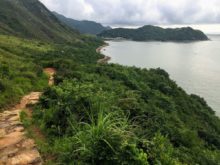Name (English): Tung O Ancient Trail
Name (Chinese): 東澳古道
Category: Outdoor activities
Address (English): Tung O Ancient Trail, Tung Chung
Address (Chinese): 東涌東澳古道
Address Google Map Link: https://goo.gl/maps/CqEz73zYuNzasMs16
Address longitude and latitude: 22.284045843023552, 113.92584563241239
Opening Hours:
MON 00:00 – 23:59
TUE 00:00 – 23:59
WED 00:00 – 23:59
THU 00:00 – 23:59
FRI 00:00 – 23:59
SAT 00:00 – 23:59
SUN 00:00 – 23:59
Recommended Time to Visit: 10:00 – 14:00
Accessibility Note: Need to walk up stairs
Reminder: Total 14km, Estimate 4 – 5 hours
One of the most popular weekend activities of Hong Kongers is to go hiking. Possessing both beautiful mountains, hills and sea views, the city offers a myriad of hiking trails, and the Tung O Ancient Trail is a must-see.
Located on the northern shore of Lantau Island, where one can find relics of the earliest human activities in Hong Kong, the Tung O trail is one of the handful trails that have a historical significance. Once an important passage for villagers to commute to and from Tung Chung and Tai O fishing village before the city’s urbanisation, the trail is about 14 km long, and passes through many landmark points of cultural and archeological significance like the Tung Chung Fort and Yeung Hau Temple. Starting at Tung Chung, now mostly a residential district with an outlet mall, following a paved cement footpath (most of the trail is paved and easy) abandoned stone village houses are dotted around, a reminiscence of frugal past lives of farmers and fishermen. Built with bricks and tiled roofs, some houses still have remnants of their times, like posters or good luck calligraphy fading into the walls. Mangrove trees grow amongst the water, a common shrub seen in the saline coastline of Hong Kong.
If the tide is low, you may catch sight of the quirky Mudskipper, a kind of amphibious fish that climb out of holes in the mud and crawl about on land! Fishing has dwindled almost to zero, as the waters have been polluted in recent years due to heavy construction of the Hong Kong-Macau-Zhuhai bridge upstream.
Tung Chung Fort was originally built in the late 12th century, to protect the city from salt smugglers and pirates. (link To be provided). At one time, as many as 300 soldiers were stationed there, building the fort, the arched gateways and its six cannons. Making your way down the path, you will reach a rather steep hike along a mountain trail, where you will be rewarded with a stunning panorama of the sea. Going down, you arrive into Tai O (Link), a historical fishing town on the western side of Lantau. For the past three centuries, fishermen have been based there, building the iconic stilt houses on scaffolding right above the water. Now a popular tourist destination, the village is populated mostly by elderly people who still sell handmade shrimp paste and salted fish. You can have a break at a restaurant above the water to enjoy the sunset, or even go on a boat trip to try your luck and see some Chinese white dolphins (link To be provided), a rare but unforgettable sight to see as their population is dwindling.

After marvelling at the plethora of sundried sealife (you can even purchase a dried pufferfish!) Make your way to the oldest building in Tai O — Yeung Hau Temple. A declared monument, it was built in 1699, according to legend, to honour a local villager called Yeung Hau who cured the emperor of an illness. You can enter the temple respectfully, and marvel at the fantastic statuettes and colourful decorations and offerings amidst the clouds of incense smoke.
#TungO #LautauIsland #discoverhongkong #explorehongkong #visithongkong #hongkongtravel #ilovehk #nature #hongkongnature #naturelovers #naturelover #naturephotography #hiker #outdoors #outdoor #natureshots #visualhongkong #capturehongkong


